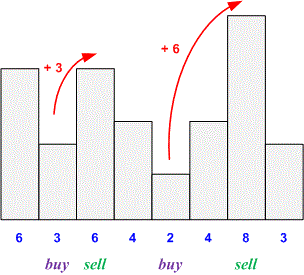Editorial
Let's consider how the stock price changes every day. If the price increases from day to day , then we include the difference in the total profit.
Example
Consider the first example.

The profit will be .
Algorithm realization
Read the input data.
scanf("%d", &n);
prices.resize(n);
for (i = 0; i < n; i++)
scanf("%d", &prices[i]);In the variable , we compute the maximum possible profit.
res = 0; for (int i = 1; i < prices.size(); i++)
If the stock price increases from day to day , then we add the profit to the result .
if (prices[i] > prices[i - 1])
res += prices[i] - prices[i - 1];Print the answer.
printf("%d\n", res);Python realization
Read the input data.
n = int(input()) prices = list(map(int, input().split()))
In the variable , we compute the maximum possible profit.
res = 0 for i in range(1, len(prices)):
If the stock price increases from day to day , then we add the profit to the result .
if prices[i] > prices[i - 1]:
res += prices[i] - prices[i - 1]Print the answer.
print(res)